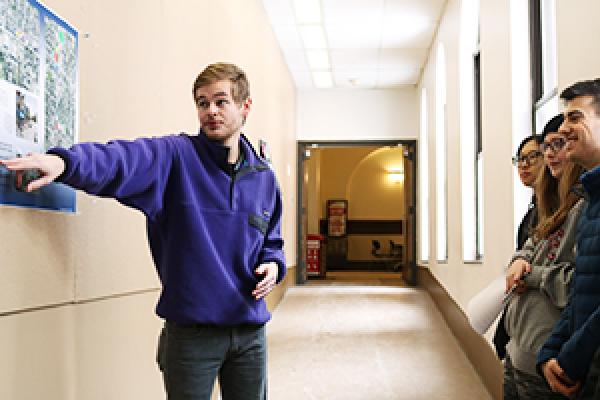Teaching collaboration merges food sustainability, visual design

By 2025, Ohio State plans to source 40 percent of on-campus food locally and sustainably.
This ambitious commitment to future sustainability serves as the backdrop for the Food Futures: Design + Comparative Studies Teaching Cluster, a teaching collaboration between comparative studies senior lecturer Rick Livingston, associate professor of design Peter Chan and associate professor of English Ben McCorkle. The collaboration is housed within the Global Arts and Humanities Discovery Theme’s Livable Futures project, which encourages innovation and collaboration across disciplines to address societal and planetary issues.
Sustainability, as defined by Ohio State’s Food Sustainability Panel, considers the environmental soundness, economic viability and social impact of how the university sources its food.
“How do you promote the idea about local and sustainable food to a broad audience at the university?” Livingston said. “How does the university fit into the larger landscape of American food? What lessons does the university teach about food?”
These are questions Livingston and Chan’s students are tasked with answering through a variety of collaborative design projects. Students in Livingston’s American Food Cultures course gather with students in Chan’s Visual Communication Design course, combining their respective curricula and knowledge to create an assorted array of signage, posters and sketchbooks to illustrate and represent not only the university’s goal of food sustainability, but the future of food in general.
“The comparative studies students will be focused more on the larger food culture and would be doing more reading and writing,” Chan said. “The visual communication design students try to find a way to visually represent it.”
Livingston and Chan collaborated a year ago when Livingston spoke with Chan’s students about water as a cultural phenomenon, after which Chan’s students created water-themed posters that were displayed at the university’s Faculty Club forum in conjunction with World Water Day.
Leading up to spring semester 2019, the duo wanted to get together again. Livingston, who is on the executive committee of Ohio State’s Food and AgriCultural Transformation Discovery Theme and who’d recently developed his course on American food cultures, suggested they center their collaboration this time on food.
“The [Ohio State food sustainability] report is a huge commitment and enterprise, and it raises all sorts of interesting questions,” Livingston said. “That created a real-world context for our working together and for the students to think about how to communicate the idea about local and sustainable food to a broad audience at the university.”
While Livingston and Chan will focus on the project from their respective academic viewpoints, McCorkle, whose expertise lies in rhetoric and composition, will act as consultant for the students as they develop their ideas. He will also observe and document the project’s development and implementation, which will serve to design collaborations in the future.
“The ultimate goal of this whole experience is to design something that’s robustly collaborative,” McCorkle said. “Not just between us, but between the students, the university and the community members who are coming in to talk and give their expertise.”
